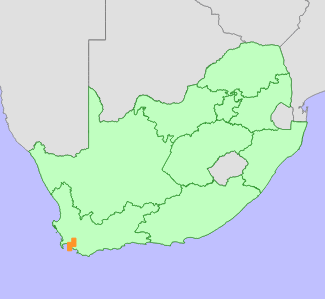|
Scientific Name | Senecio speciosissimus J.C.Manning & Goldblatt |
Higher Classification | Dicotyledons |
Family | ASTERACEAE |
National Status |
Status and Criteria | Rare |
Assessment Date | 2007/10/10 |
Assessor(s) | P.A. Manyama |
Justification | A short-lived, post fire pioneer species known from two sites (EOO <100 km²). It has lost habitat to afforestation in the past but there are no current threats impacting it. |
Distribution |
Endemism | South African endemic |
Provincial distribution | Western Cape |
Range | Bain's Kloof to Kogelberg. |
Habitat and Ecology |
Major system | Terrestrial |
Major habitats | Kogelberg Sandstone Fynbos, Hawequas Sandstone Fynbos |
Description | Moist fynbos vegetation, in seepage areas or along streams, 600-1500 m. |
Threats |
| About 20% of this species' habitat was lost to forestry plantations in the past, however, loss is not ongoing. |
Population |
Plants seem to be relatively short lived and the species is apparently a member of early successional communities that do not persist into more mature fynbos older than 10 years (Goldblatt and Manning 2005).
|
Population trend | Stable |
Assessment History |
Taxon assessed |
Status and Criteria |
Citation/Red List version | | Senecio speciosissimus J.C.Manning & Goldblatt | Rare | Raimondo et al. (2009) | |
Bibliography |
Goldblatt, P. and Manning, J.C. 2005. Two new species of Asteraceae from Northern and Western cape, South Africa, and a new synonym. Bothalia 35(1):55-61.
Raimondo, D., von Staden, L., Foden, W., Victor, J.E., Helme, N.A., Turner, R.C., Kamundi, D.A. and Manyama, P.A. 2009. Red List of South African Plants. Strelitzia 25. South African National Biodiversity Institute, Pretoria.
|
Citation |
| Manyama, P.A. 2007. Senecio speciosissimus J.C.Manning & Goldblatt. National Assessment: Red List of South African Plants version 2024.1. Accessed on 2025/12/12 |
 Comment on this assessment
Comment on this assessment


